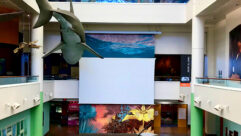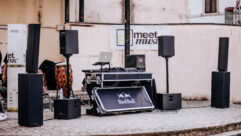Chicago Field Museum of Natural History’s James Simpson Theater, Part 1
Mar 10, 2014 12:44 PM,
With Bennett Liles | Posted by Jessaca Gutierrez

Listen to the Podcasts
Editor’s note: For your convenience, this transcription of the podcast includes timestamps. If you are listening to the podcast and reading its accompanying transcription, you can use the timestamps to jump to any part of the audio podcast by simply dragging the slider on the podcast to the time indicated in the transcription.

When Chicago’s Field Museum of Natural History decided to upgrade the sound system at its James Simpson Theater. Clearwing Productions was called in to install an L-Acoustics system. Megan Henninger is with us today to describe a challenging project in an old and historic building. Coming right up on the SVC Podcast.
Megan, thanks for joining us on the SVC Podcast from a pretty frigid Wisconsin.
Milwaukee, Wis.
And as we record this it’s unbelievably cold up there.
Not quite as cold, but more than cold enough for me.
And what’s been going on lately at Clearwing Productions? That’s a very interesting name. I don’t think you’re going to be confused with anybody else.
No. In my department, which is the systems integration department, we just finished up an arena lighting install at U. W. Madison’s Kohl Center Arena for their hockey and basketball teams, so that was fun. We’re right now working on a combo package for a house of worship; sound, lighting and video. [Timestamp: 1:28]
I’m sure that’s enough to keep everybody there busy. We were going to talk about the James Simpson Theater in the Chicago Field Museum of Natural History. I looked at their website and it looks like you could spend at least a week there and not see everything they have. I understand they have some corporate events there. What all goes on there?
The James Simpson Theater, with the project that we were involved in through Frost Chicago, they converted it from a rarely used kind of a corporate space to now it’s a dual-purpose and it’s primarily used for 3D cinema, which is what the sound system is for. But they still rent it out for meetings on occasion, so corporate meetings, that kind of thing. [Timestamp: 2:10]
I’ll include their website link in the show notes for this but the place just looks so clean and white. It would be incredibly easy for a sound system or any sort of technical system just to look like mud on a wedding dress in that beautiful room. Your guys had to be really careful about what they did in there.
Yeah, we definitely did. The visual integrity of this space was one of the primary concerns for the museum. As you mentioned, it’s pretty wide open. There are not a lot of places to hide things there. We had to get pretty creative in our speaker placement. [Timestamp: 2:44]
What were they doing before that as far as a sound system? Did you have to take anything out to get all this set up?
We did take some stuff out. If you’re looking at the pictures, you can see there’s a couple of tiny grilles to the left and right of the proscenium and up near the ceiling. They’re kind of decorative. And they had a couple of speakers placed up there and as you can see … there’s not a great way to aim anything up there and keep it behind the grille, so they were just kind of shooting out into the room without being directed at anything. So the sound quality was poor, intelligibility was poor; the sound sources weren’t really aimed at the audience members at all. It had been problematic for them, even in the corporate setting. As I understand it they would bring often a sound system in for corporate events so they could get better coverage of the room. [Timestamp: 3:33]
Chicago Field Museum of Natural History’s James Simpson Theater, Part 1
Mar 10, 2014 12:44 PM,
With Bennett Liles | Posted by Jessaca Gutierrez

And I think that you mentioned before that they had the new 3D projector and that was the main motivator for having a new sound system to go with it?
Yeah. Yeah, it was. We were subcontracted through Frost Chicago to do the audio and D3D who was contracted through Frost 3D cinema because that’s kind of a niche market there. Frost really wanted L-Acoustics in the room, which is why they contacted us and we worked with them and with D3D to find a placement that was going to work both aesthetically and for the integrity of both 3D cinema playback, which is much different from concert reinforcement, and the system will also work for their corporate meetings as well, providing better coverage than the previous system. So now they don’t have to bring their own audio production into the room when it’s rented out by a corporation. [Timestamp: 4:27]
So you went with the L-Acoustics ARCS and I believe a couple of models of their XT speaker series for this. What was the attraction with the ARCS gear?
Well, the ARCS we’ve used before and as far as size and the ability to place them in the space with minimal visual impact, the size was important, basically quality is important. With L-Acoustics you get great sound quality from their speakers. You know, with the combination of the needs of the space and the desire for really high-end sound quality in there that led us to choose the ARCS. And then the XT series, 12XTs were used around the room for surround because they provided enough punch and volume, and also they were small enough to blend into the space well. And we purchased the white version so it would blend into the room and not interrupt the visual continuity of the space. [Timestamp: 5:23]
Yeah, anything other than white in there would really stand out in that place.
Yes. It’s a wide-open room. It the kind, I guess you could say it’s naked. You put something that doesn’t belong in there and you’re going to notice it right away. [Timestamp: 5:35]
It’s interesting how you did the ten 8XTi enclosures. I think there are eight on the sides of the room and two in the back. I think those are only something like 16.5in. high so they can pretty well fit anywhere I guess.
Yeah, they’re pretty low profile, so that was really important to try to make them blend with the room.
And then I think you had four 5XT coaxial cabinets behind a grill on the face of the stage. How did that work? Those are something like a six and a half inch cube so they’re even smaller and they handle, I think, 85W but how did you get those into the face of the stage?
They’re tiny. You can’t tell from the pictures, but the face of the stage there is just a kind of metal, very open metal grille. There’s space underneath the stage where they had previously had some EAW boxes under there. We replaced them with the 5XTs to match the rest of the system because you can get incredible volume and clarity out of those little guys. And we wanted to be sure that the first few rows were well-covered for the cinema; we just sat the center channel through the little 5XTs to make sure that everything was clearly intelligible to the people in the first few rows and that they weren’t missing anything. [Timestamp: 6:51]

How are the acoustics in that place? Was there any kind of acoustic treatment done? I guess you can’t do a whole lot because the theater is very old but it looks like it may be carpeted.
It is carpeted, thank goodness. I mean one thing going for it there. But we were not allowed to do any kind of acoustical treatment on the walls or the ceiling, so it’s pretty reverberant in there. And for that reason it was very important minimizing bounce off the walls and the ceiling and kind of keeping everything focused to the audience area so at least when there’s people in there, it’s more absorptive and more intelligible since you don’t have as much bounce as with the previous system. [Timestamp: 7:26]
And they’ve got some pretty luxurious movie theater-style seats instead of the hard wooden pew-like seats that you have in a lot of those older theaters. So what was the general speaker system design? Was it a left, center, right?
We began with the left, center, right because in cinema applications, the center channel is so important because that’s where your dialogue comes through to kind of anchor the image to the screen so it sounds like the people on screen are actually talking. And pretty much any kind of cinema server you have is going to be set up with a main and left, right, center stops and then different configurations. We started there and we had discussions about how we could do this around that. It took a little while to work out, basically because of the aesthetics of the room and still make it work for surround sound cinema. We considered placement and the challenges of hanging speakers in that old stage and having its own infrastructure, and that’s when we came up with the idea of the little front fills underneath the lip because of the challenges of not being able to hang the cabinets to minimize impact and just providing equal coverage around the space. [Timestamp: 8:41]
I know they were fairly restrictive in that old building about what you could do with it and no acoustic treatment that would visibly alter the look of the place. But behind the scenes, did you have any special problems or have to reinforce anything to fly the speakers?
We did on stage, and we were subcontracted trough Frost. Frost is a dedicated provider of the field museum, so they’re very familiar with the stage. They partnered with us and provided riggers who had been in the space before to help bring the speakers on stage for the left, center, and right clusters of the ARCS. The museum personnel—maintenance personnel—helped us with rigging the surround speakers. Because of the construction techniques used, it was tricky to provide anchor points for those 12XTis around the space. So they helped us out greatly in that respect, crawling up through the ceiling. It took quite awhile to get in and get it right, but the end result was quite worth it. [Timestamp: 9:38]
It’s a great looking place and I know they want it to sound at least that good, so I know it was a big job. Thanks for giving us the technical look at that. Megan Henninger from Clearwing Productions and the James Simpson Theater at the fantastic Chicago Field Museum of Natural History. Thanks for telling us about it.
Well thanks for having me. I appreciate the opportunity.










